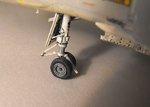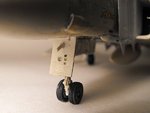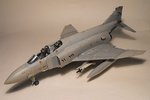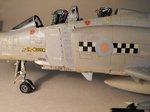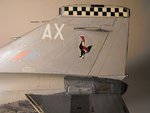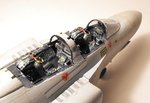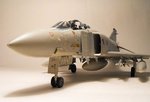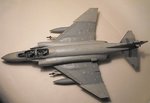Airframes
Benevolens Magister
A Condensed History in Miniature
I've long wanted to model a 'Squadron History', where every type of aircraft operated by a particular R.A.F. Squadron would be built and displayed. The original idea has been mulling around in my head for decades, with the intention being to do this in 1/72nd scale. The reason for the choice of the smaller scale was fairly simple - there are more kits available, less display space would be required, and the overall cost would be considerably less than larger scales. However, I more or less gravitated to 1/48th scale (and a growing number of 1/32nd scale) quite a few years ago, and now, unless the subject is something like a Lancaster bomber, I would find 1/72nd scale a tad difficult to handle, especially in the detailing department, due to the ongoing effects of this stupid disease that now plagues me.
But, when Jan started talking about doing a sort of 'unofficial' Group Build based on Squadrons, the idea raised its head once more and, after some careful thought, I decided I could produce a reasonable representative selection of aircraft from one Squadron in 1/48th scale, if I stuck to fighters!
I had already considered 'doing' 43 Squadron, 'The Fighting Cocks', and already have a couple of models finished in that squadron's markings. However, in order to produce a more diverse cross-section of types, I looked at other long-serving RAF squadrons, and considered both 74 and 111 Squadrons.
But, Jan beat me to those avenues, so I plumped for 56 Squadron, one of the oldest, and most famous, of the RAF's fighter squadrons.
Number 56 Squadron was formed on 8th June, 1916, as a Squadron of the British Army's Royal Flying Corps, when it flew a variety of aircraft, until equipping with the famous SE5 in March 1917. This type was supplemented, and eventually replaced, by the superior SE5A, a very advanced machine for its day, and the Squadron counted among its 'Aces' such famous names as Ball and McCudden, and had an interesting history, which I will endeavour to relate as the 'Build' develops through the stages.
The Royal Flying Corps, a Corps just like any other unit of the British Army at the time, with the obvious difference of being airborne, became an independant Force on 1st April 1918, when the Royal Air Force became the third arm of Britain's Armed Forces. At that time, 56 Squadron, now 56 Squadron Royal Air Force, were equipped with the SE5A and, until their disbandment as a fighter squadron 90 years later, on 22 April 2008, operated 18 different types of aircraft (excluding sub-types or Marks.), culminating with the Panavia Tornado F3.
The Squadron had been a 'true' fighter squadron up until 1992, when they replaced their Phantom FGR2's with the Tornado, and became 56(R) Squadron, 229 OCU - the Operational Conversion Unit for Tornado crews, based at Coningsby, in Lincolnshire. The 'R' in the title means 'Reserve', a term applied to a small number of once front-line squadrons whose role changed to that of a 'Shadow Squadron' in the training role, who would become operational in time of war or other 'emergency' or conflict, the aircraft crewed by (very experienced) instructors.
After ninety years of (almost) continuous service as a Fighter Squadron, No 56 Squadron disbanded on 22 April 2008, and the number was allocated to the AIRC21 SR OEU, operating the AWACS and Sentinel aircraft in the Intelligence and Airborne Command and Control roles.
So, it is now my intention to build a selection of the major aircraft types operated by 56(F) Squadron, in 1/48th scale, from its inception as a RAF squadron in 1918, to disbandment in 2008.
Of course, there are some restrictions that will apply, not least of which is availability and cost of the relevant kits, as well as time, and space in which to display the finished models! (I am considering donating the finished collection to the present Squadron, or a suitable museum, but that has yet to be decided upon!!)
In order to present a reasonably balanced display, I have selected 10 types which are either readily available, or can be obtained as 'out of production' kits from specialist dealers, or other outlets, at realistic prices - I do not intend to have to pay 'silly money', just for the privilege of obtaining a particular kit!
It is possible, depending on circumstances, availability, opportunity etc, that other types may be added, and, of course, some types may be deleted from the list.
It is my aim to produce these ten models over a period of between 18 months and 2 years, give or take, in between Group Builds and other modelling, writing and painting projects, and I'll be providing a brief history of the period concerned as each model-build is posted here.
The periods represented will be World War One and the 1920's, the 1930's, World War Two, the 1950's to 1960's, 1970's to 1980's, and finally, the 1980's until disbandment in 2008.
The first kit (The E.E. Lightning) has already been obtained, and another type (Phantom) is almost complete, having been built some time ago, although the squadron markings need to be changed from those of 43 Squadron. It is therefore highly probable that the builds will start with the Lightning, finished as an F1A, in the striking bright red over natural metal livery of the 'Firebirds' aerobatic display team of the 1960's.
So, the intended line-up is as follows, availability permitting:-
SE5A
Bristol Bulldog MkIIA
Gloster Gladiator Mk1
Hawker Hurricane Mk1
Hawker Tempest MkV
Gloster Meteor F4
Hawker Hunter F6
E.E. Lightning F1A
McD.D. Phantom FGR2.
Panavia Tornado F3.
At least four of the above kits are out of production, although I have traced sources for those particular ones, and have already obtained one (Lightning). Some of the manufacturers chosen possibly aren't the best kits on the market, but they are good enough and, more importantly, don't cost a King's ransom!
If one or more of those chosen should be unavailable when the time comes to obtain them, then it may well be that another type will be substituted. For example, I am aiming to use the Esci Tempest, and I also know that the Eduard kit, which itself is, I believe, based on the Esci kit, is also available, at much greater cost, but should this situation change, it may be that I will substitute a Typhoon, either the Monogram or Hasegawa kit, or perhaps even a Spitfire MkIX, even though this type was only used by the Squadron for two months.
So, that's the plan - hopefully!
With a bit of luck, and continued enthusiasm, plus a lot of time and patience, I hope to be able to provide a series of informative and entertaining builds over the coming months, fingers crossed!
Thanks for looking, and I hope you'll be able to see the first build in the not too distant future.
Terry.
I've long wanted to model a 'Squadron History', where every type of aircraft operated by a particular R.A.F. Squadron would be built and displayed. The original idea has been mulling around in my head for decades, with the intention being to do this in 1/72nd scale. The reason for the choice of the smaller scale was fairly simple - there are more kits available, less display space would be required, and the overall cost would be considerably less than larger scales. However, I more or less gravitated to 1/48th scale (and a growing number of 1/32nd scale) quite a few years ago, and now, unless the subject is something like a Lancaster bomber, I would find 1/72nd scale a tad difficult to handle, especially in the detailing department, due to the ongoing effects of this stupid disease that now plagues me.
But, when Jan started talking about doing a sort of 'unofficial' Group Build based on Squadrons, the idea raised its head once more and, after some careful thought, I decided I could produce a reasonable representative selection of aircraft from one Squadron in 1/48th scale, if I stuck to fighters!
I had already considered 'doing' 43 Squadron, 'The Fighting Cocks', and already have a couple of models finished in that squadron's markings. However, in order to produce a more diverse cross-section of types, I looked at other long-serving RAF squadrons, and considered both 74 and 111 Squadrons.
But, Jan beat me to those avenues, so I plumped for 56 Squadron, one of the oldest, and most famous, of the RAF's fighter squadrons.
Number 56 Squadron was formed on 8th June, 1916, as a Squadron of the British Army's Royal Flying Corps, when it flew a variety of aircraft, until equipping with the famous SE5 in March 1917. This type was supplemented, and eventually replaced, by the superior SE5A, a very advanced machine for its day, and the Squadron counted among its 'Aces' such famous names as Ball and McCudden, and had an interesting history, which I will endeavour to relate as the 'Build' develops through the stages.
The Royal Flying Corps, a Corps just like any other unit of the British Army at the time, with the obvious difference of being airborne, became an independant Force on 1st April 1918, when the Royal Air Force became the third arm of Britain's Armed Forces. At that time, 56 Squadron, now 56 Squadron Royal Air Force, were equipped with the SE5A and, until their disbandment as a fighter squadron 90 years later, on 22 April 2008, operated 18 different types of aircraft (excluding sub-types or Marks.), culminating with the Panavia Tornado F3.
The Squadron had been a 'true' fighter squadron up until 1992, when they replaced their Phantom FGR2's with the Tornado, and became 56(R) Squadron, 229 OCU - the Operational Conversion Unit for Tornado crews, based at Coningsby, in Lincolnshire. The 'R' in the title means 'Reserve', a term applied to a small number of once front-line squadrons whose role changed to that of a 'Shadow Squadron' in the training role, who would become operational in time of war or other 'emergency' or conflict, the aircraft crewed by (very experienced) instructors.
After ninety years of (almost) continuous service as a Fighter Squadron, No 56 Squadron disbanded on 22 April 2008, and the number was allocated to the AIRC21 SR OEU, operating the AWACS and Sentinel aircraft in the Intelligence and Airborne Command and Control roles.
So, it is now my intention to build a selection of the major aircraft types operated by 56(F) Squadron, in 1/48th scale, from its inception as a RAF squadron in 1918, to disbandment in 2008.
Of course, there are some restrictions that will apply, not least of which is availability and cost of the relevant kits, as well as time, and space in which to display the finished models! (I am considering donating the finished collection to the present Squadron, or a suitable museum, but that has yet to be decided upon!!)
In order to present a reasonably balanced display, I have selected 10 types which are either readily available, or can be obtained as 'out of production' kits from specialist dealers, or other outlets, at realistic prices - I do not intend to have to pay 'silly money', just for the privilege of obtaining a particular kit!
It is possible, depending on circumstances, availability, opportunity etc, that other types may be added, and, of course, some types may be deleted from the list.
It is my aim to produce these ten models over a period of between 18 months and 2 years, give or take, in between Group Builds and other modelling, writing and painting projects, and I'll be providing a brief history of the period concerned as each model-build is posted here.
The periods represented will be World War One and the 1920's, the 1930's, World War Two, the 1950's to 1960's, 1970's to 1980's, and finally, the 1980's until disbandment in 2008.
The first kit (The E.E. Lightning) has already been obtained, and another type (Phantom) is almost complete, having been built some time ago, although the squadron markings need to be changed from those of 43 Squadron. It is therefore highly probable that the builds will start with the Lightning, finished as an F1A, in the striking bright red over natural metal livery of the 'Firebirds' aerobatic display team of the 1960's.
So, the intended line-up is as follows, availability permitting:-
SE5A
Bristol Bulldog MkIIA
Gloster Gladiator Mk1
Hawker Hurricane Mk1
Hawker Tempest MkV
Gloster Meteor F4
Hawker Hunter F6
E.E. Lightning F1A
McD.D. Phantom FGR2.
Panavia Tornado F3.
At least four of the above kits are out of production, although I have traced sources for those particular ones, and have already obtained one (Lightning). Some of the manufacturers chosen possibly aren't the best kits on the market, but they are good enough and, more importantly, don't cost a King's ransom!
If one or more of those chosen should be unavailable when the time comes to obtain them, then it may well be that another type will be substituted. For example, I am aiming to use the Esci Tempest, and I also know that the Eduard kit, which itself is, I believe, based on the Esci kit, is also available, at much greater cost, but should this situation change, it may be that I will substitute a Typhoon, either the Monogram or Hasegawa kit, or perhaps even a Spitfire MkIX, even though this type was only used by the Squadron for two months.
So, that's the plan - hopefully!
With a bit of luck, and continued enthusiasm, plus a lot of time and patience, I hope to be able to provide a series of informative and entertaining builds over the coming months, fingers crossed!
Thanks for looking, and I hope you'll be able to see the first build in the not too distant future.
Terry.


